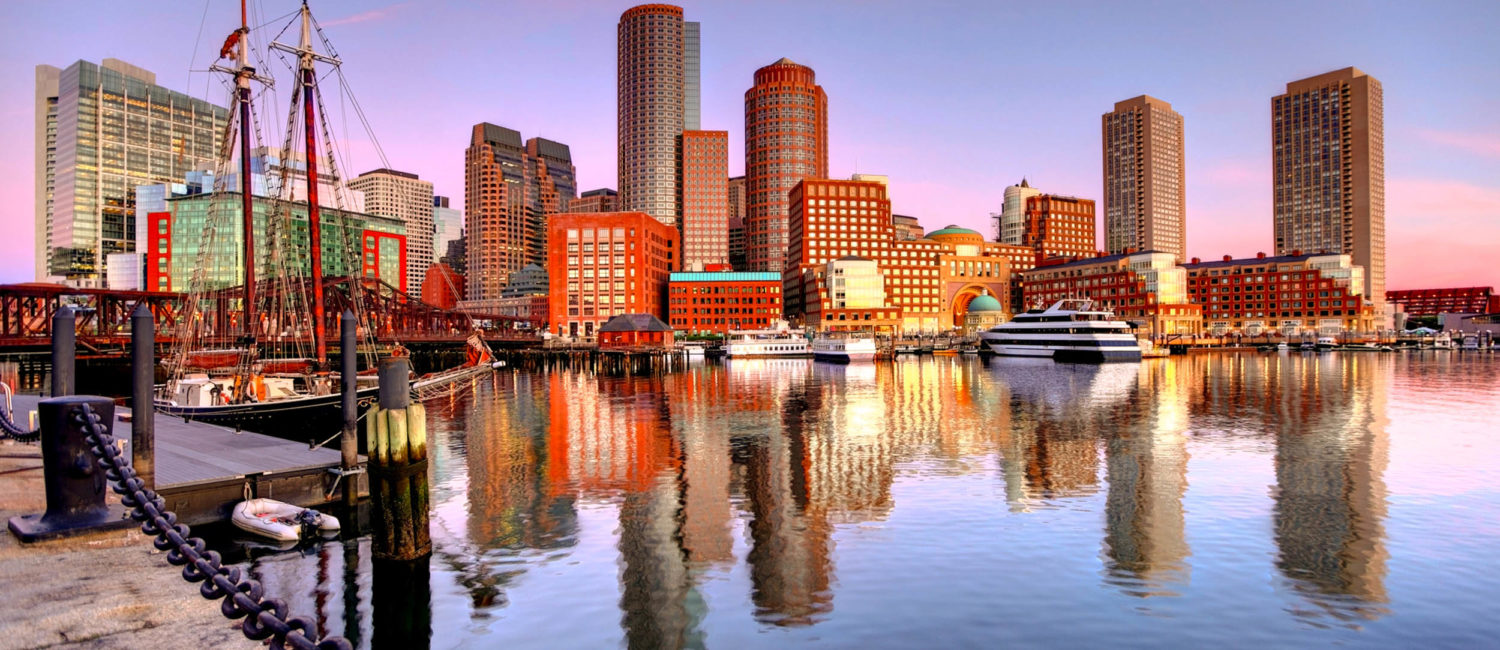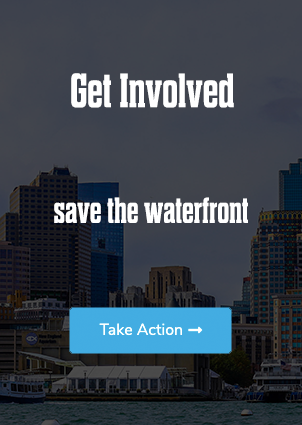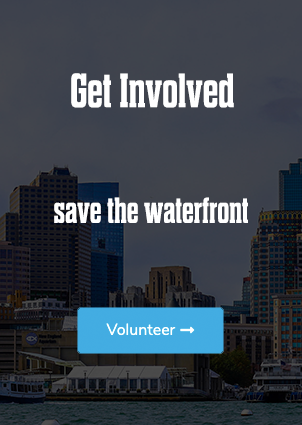Where is the Downtown Waterfront?
The Downtown Waterfront is a 42-acre area that stretches from the North End to Fort Point. It represents a special civic space in our coastal city that sits between Boston Harbor and the Rose Kennedy Greenway, and is ripe for enhancing connections and fostering community. Together, we can save Boston’s waterfront and foster a waterfront for all.
The spaces surrounding Boston’s public waterfront are the product of public investment of taxpayer dollars that cleaned up Boston Harbor, buried the Central Artery, and created The Greenway.
What is Chapter 91, the Public Waterfront Act? How does it apply to the downtown waterfront?
The Massachusetts Public Waterfront Act (Chapter 91) is the “Commonwealth’s primary tool for protection and promotion of public use of its tidelands and other waterways, [a] waterways licensing program.The Commonwealth formally established the program in 1866, but the philosophy behind Chapter 91 dates back to the earliest days of the Massachusetts Bay Colony, most notably in the Colonial Ordinances of 1641–1647.”
“The Colonial Ordinances codified the ‘public trust doctrine,’ a legal principle that dates back nearly 2000 years, which holds that the air, the sea and the shore belong not to any one person, but rather to the public at large. Through Chapter 91, the Commonwealth seeks to preserve and protect the rights of the public, and to guarantee that private uses of tidelands and waterways serve a proper public purpose.”
What would a Downtown Waterfront for All mean for Boston, its residents, and visitors to our coastal city?
Through a robust community process to address district-wide challenges and opportunities, a Downtown Waterfront for All would advance a more climate resilient and equitable future for our city through a waterfront plan that makes this special civic space more resilient, accessible, and inclusive for everyone.
As the climate crisis worsens and inequality persists, the waterfront is a place where we can further climate action by working together to address social and environmental injustices in our city. Doing so will create opportunities for all Bostonians—regardless of race, ethnicity, or socioeconomic status—to truly reach an equitable recovery.
What is the current status of the Downtown Waterfront Municipal Harbor Plan (MHP)?
A group including waterfront residents and the Conservation Law Foundation filed suit in 2018, seeking to overturn the Downtown Waterfront Municipal Harbor Plan (MHP). In April 2021, a Suffolk Superior Court judge found in their favor, rendering the plan unenforceable by both city and the state.
After the ruling, Acting Mayor Kim Janey said the city would restart the process to develop a new MHP. That policy was continued by Mayor Michelle Wu when she took office in November.
Mayor Wu formally announced the start of a new MHP on February 16, 2022, calling for an inclusive, forward-thinking process that would include East Boston as well as the downtown waterfront:
“As a coastal city vulnerable to rising seas and extreme weather, Boston must be a national leader in driving a just transition to a thriving, green economy. We have to get this right on the waterfront and truly plan for equitable access and climate resiliency in these critical areas of our city. That’s why we are officially taking on our Downtown Municipal Harbor Plan and the East Boston harbor planning process with these goals guiding our engagement.”
The ruling was appealed to the Massachusetts Supreme Judicial Court, which heard oral arguments in March 2022.
What has Mayor Michelle Wu and the Boston City Council said about the Downtown Waterfront MHP?
“We are looking to, in some ways, hit a little bit of a reset on that process to really center resiliency, equity, access to the waterfront, and (to) make sure that in the limited time that we have, we can’t get this wrong at the waterfront,” Mayor Wu said in a February 2022 interview with GBH News.
Mayor Michelle Wu and the Boston City Council agree that we must amend the MHP to modernize the process to be more inclusive and incorporate contemporary data on climate change. This is a direct result of hearing from local residents that doing so was a priority.
What is the Blueway?
The Blueway is a reimagined, climate resilient Central Wharf that features a renovated Aquarium surrounded by an accessible and inclusive public space. The Blueway better enables us to provide a welcoming educational space that connects people from across the city and visitors to Boston’s waterfront, and inspires us all to protect and promote the ocean. This work is at the heart of our conservation mission, which will be harmed if this proposal moves forward.
Is this just a downtown issue? How does it affect people in neighborhoods farther away, like Mattapan and Jamaica Plain?
Boston’s public waterfront is for everyone and the 42-acre Downtown Waterfront represents a central place and special civic space for people to come together. Boston’s waterfront remains a natural and precious resource that should be utilized for public recreation, education, and economic development opportunities. As such, all Boston residents from across the city should have a say in shaping the future of our city’s public waterfront.
Does the Aquarium want to keep the Harbor Garage? What is the current status of the proposed redevelopment on the site of the Harbor Garage?
Boston needs to move beyond a parcel-by-parcel approach to development that shortchanges the public by failing to advance comprehensive visions for our city’s neighborhoods. Boston can make better use of this site along the public waterfront than a parking garage or an overbearing and inaccessible tower. The challenges of climate change and inequality in our city require district-wide, comprehensive solutions that center the needs of people and their communities in both the planning process and the ultimate design and use for this site. In saving the public’s waterfront, we can advance an accessible, inclusive, vibrant, and climate resilient waterfront for all.
How does this fit with the Aquarium's mission?
Though we are well known as a destination for visitors from around the world who are interested in marine life, the Aquarium’s core mission is ocean conservation.
Given the intersection between sea level rise and climate change, creating a world-class approach to community resiliency in Boston’s neighborhoods and along its waterfront is essential. Advocating for a district-wide plan for a climate ready downtown waterfront and opposing a project that ignores the need to address climate change or advance environmental justice is consistent with our mission.
Are there others involved in bringing the pressing issues facing Boston’s harbor, its public waterfront, and other waterways to the forefront of the public conversation? Is there public polling on these issues?
In July 2021, a group of organizations came together to create the Coalition for a Resilient and Inclusive Waterfront (CRIW), “an alliance of nearly 50 organizations that is focused on advancing a bold vision for the future of the City’s waterfront that prioritizes resilience, inclusivity, access, and economic vitality through voter and civic leader education and engagement.”
A December 2021 poll found continued support for the creation and preservation of open spaces on the waterfront and the essential public health role they play for the city, as well as broad support for increased accessibility on the waterfront, and neighborhood efforts to address and prepare for the challenges brought by climate change. Seventy percent of voters call it “very important” that the waterfront “improves the public health of the City by providing open spaces for exercise and enjoyment.”



